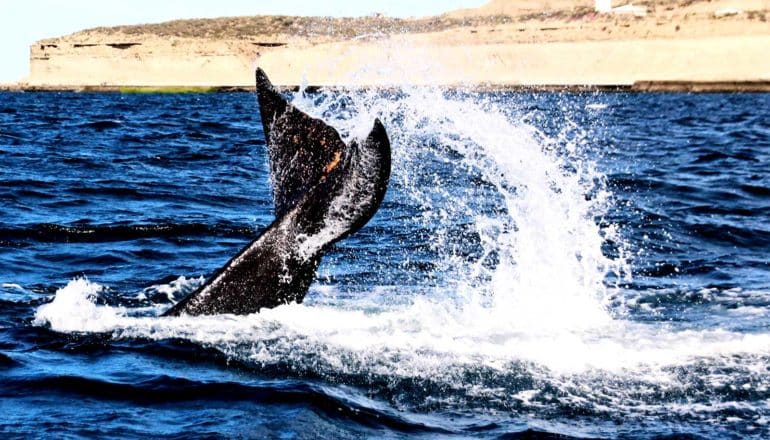
A newly-described fossil whale represents a new species and an important step in the evolution of whale locomotion, researchers report.
Scientists recovered the fossilized remains of Aegicetus gehennae in the Egyptian desert in 2007 and dated them to around 35 million years ago. The creature appears to have adapted for swimming through undulation of the mid-body and tail, somewhat as crocodiles swim today, says Philip Gingerich, professor emeritus in the earth and environmental sciences department and curator emeritus at the Museum of Paleontology.
The fossil record of whale evolution tracks the transition from land-dwelling ancestors to ocean-dwelling cetaceans. Protocetids are a group of early, semi-aquatic whales known from the middle of the Eocene, a geological epoch that began 56 million years ago and ended 33.9 million years ago. Scientists have found Protocetid remains in Africa, Asia, and the Americas.
While modern whales are fully aquatic and use their tails to propel themselves through the water, scientists think most protocetids were semi-aquatic and swam mainly with their limbs.
Feet to tail
In the PLOS ONE paper, Gingerich and colleagues describe a new genus and species, Aegicetus gehennae, the first late-Eocene protocetid. Its body shape is similar to that of other ancient whales of its time, such as the famous Basilosaurus.
The researchers suggest that an undulatory swimming style might represent a transitional stage between the foot-powered swimming of early whales and the tail-powered swimming of modern whales.
“Early protocetid whales living 47 to 41 million years ago were foot-powered swimmers. Later, starting about 37 million years ago, whales became tail-powered swimmers,” Gingerich says.
“This newly discovered fossil whale, Aegicetus, was intermediate in time and form and was transitional functionally in having the larger and more powerful vertebral column of a tail-powered swimmer,” says Gingerich, also a professor emeritus of ecology and evolutionary biology and of anthropology.
Mostly complete whale fossil
Researchers discovered the fossilized bones in the Wadi Al Hitan World Heritage Site in the Western Desert of Egypt. Aegicetus is the youngest-known protocetid and is known from one exceptionally complete skeleton—roughly two-thirds of the individual’s bones were recovered—and a partial second specimen, making it among the best-preserved ancient whales.
Researchers believe the mostly complete specimen was a male. It would have weighed nearly 2,000 pounds in life and would have been about 12 feet long.
Compared with earlier whales, Aegicetus has a more elongated body and tail and smaller back legs, and it lacks a firm connection between the hind legs and the spinal column. These adaptations indicate an animal that was more fully aquatic and less of a foot-powered swimmer than its ancestors.
The original fossils are at the Museum of Paleontology for study but will soon return to the Egyptian Geological Museum in Cairo. Molds and casts of nearly all of the specimens will remain in Ann Arbor.
Three-dimensional photogrammetric models of all the Aegicetus vertebrae and some of the limb bones are available for viewing online at the University of Michigan’s Museum of Paleontology’s UMORF imagery archive. Type “Aegicetus” in the search box.
Additional coauthors are from the Egyptian Environmental Affairs Agency and the Saudi Geological Survey.
The Egyptian Geological Museum, the Egyptian Environmental Affairs Agency, the Egyptian Mineral Resources Authority, the University of Michigan Museum of Paleontology, the US National Science Foundation, and the National Geographic Society funded the work.
Researchers collected and studied specimens described in the paper following protocols outlined in a three-way memorandum of understanding between the Egyptian Geological Survey and Mining Authority, the Egyptian Environmental Affairs Agency, and the University of Michigan.
Source: University of Michigan
The post Whale fossil bridges gap between foot- and tail-powered swimming appeared first on Futurity.
from Futurity https://ift.tt/2POA0I2
No comments:
Post a Comment